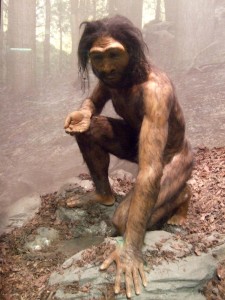Notice Visitors, Create Joyful Gallery
The Armchair Museum Visitor
Seeing Voices in the Museum
Evolution galleries: Humans and other animals

I’ve been interested in human evolution ever since spending time learning about it during my Human Sciences degree in the late nineties, so whenever I’m in a museum with a human evolution gallery, my antennae start quivering. I’ve visited a couple in the USA over the past few years — one in the American Museum of Natural History in New York, and, last year, in the Smithsonian National Museum of Natural History. I just love the idea of looking back at our ancestors, and also of being reminded that over the past few million years other species of humans and hominids have existed, often in parallel with each other.
I’m used to seeing these galleries, or even the single human evolution cases in some museums, presenting the various human species on their own, or maybe alongside a few other primates. The museums nip off a single twig of the evolutionary tree, usually starting with modern humans evolving from something like an australopithecus, and maybe hinting that these evolved from an earlier primate species.
[Read More]Welcome to the gallery of the real
Some time last year I was in a natural history gallery with a Natural History Museum educator from the USA. I asked her, “What question do children most commonly ask in your museum?”, already anticipating that the answer would be, “Is it real?”. I was right, of course, with children’s favoured question number two, on both sides of the pond, being, “Did you kill it?”.
The world over, young children seem to be totally baffled by taxidermy. A couple of months ago I visited the Oxford University Museum of Natural History with my two nephews, aged seven and four. They spent most of the visit trying to get their heads around the relationship between ‘real', ‘alive' and ‘dead'. “But when are we going to see the real ones?”, they kept asking. And they weren’t convinced by my patient, rational response that these were real, they were just the skins of dead animals that someone had stuffed to make them look alive. To the boys, ‘real' meant ‘alive'
[Read More]